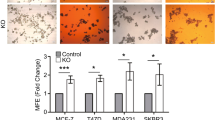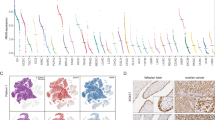Abstract
The cancer stem cell hypothesis posits that malignant growth arises from a rare population of progenitor cells within a tumor that provide it with unlimited regenerative capacity. Such cells also possess increased resistance to chemotherapeutic agents. Resurgence of chemoresistant disease after primary therapy typifies epithelial ovarian cancer and may be attributable to residual cancer stem cells, or cancer-initiating cells, that survive initial treatment. As the cell surface marker CD133 identifies cancer-initiating cells in a number of other malignancies, we sought to determine the potential role of CD133+ cells in epithelial ovarian cancer. We detected CD133 on ovarian cancer cell lines, in primary cancers and on purified epithelial cells from ascitic fluid of ovarian cancer patients. We found CD133+ ovarian cancer cells generate both CD133+ and CD133− daughter cells, whereas CD133− cells divide symmetrically. CD133+ cells exhibit enhanced resistance to platinum-based therapy, drugs commonly used as first-line agents for the treatment of ovarian cancer. Sorted CD133+ ovarian cancer cells also form more aggressive tumor xenografts at a lower inoculum than their CD133− progeny. Epigenetic changes may be integral to the behavior of cancer progenitor cells and their progeny. In this regard, we found that CD133 transcription is controlled by both histone modifications and promoter methylation. Sorted CD133− ovarian cancer cells treated with DNA methyltransferase and histone deacetylase inhibitors show a synergistic increase in cell surface CD133 expression. Moreover, DNA methylation at the ovarian tissue active P2 promoter is inversely correlated with CD133 transcription. We also found that promoter methylation increases in CD133− progeny of CD133+ cells, with CD133+ cells retaining a less methylated or unmethylated state. Taken together, our results show that CD133 expression in ovarian cancer is directly regulated by epigenetic modifications and support the idea that CD133 demarcates an ovarian cancer-initiating cell population. The activity of these cells may be epigenetically detected and such cells might serve as pertinent chemotherapeutic targets for reducing disease recurrence.
This is a preview of subscription content, access via your institution
Access options
Subscribe to this journal
Receive 50 print issues and online access
$259.00 per year
only $5.18 per issue
Buy this article
- Purchase on Springer Link
- Instant access to full article PDF
Prices may be subject to local taxes which are calculated during checkout




Similar content being viewed by others
References
Balch C, Nephew KP, Huang TH, Bapat SA . (2007). Epigenetic ‘bivalently marked’ process of cancer stem cell-driven tumorigenesis. Bioessays 29: 842–845.
Bapat SA, Mali AM, Koppikar CB, Kurrey NK . (2005). Stem and progenitor-like cells contribute to the aggressive behavior of human epithelial ovarian cancer. Cancer Res 65: 3025–3029.
Barrett T, Troup DB, Wilhite SE, Ledoux P, Rudnev D, Evangelista C et al. (2007). NCBI GEO: mining tens of millions of expression profiles—database and tools update. Nucleic Acids Res 35: D760–D765.
Beier D, Hau P, Proescholdt M, Lohmeier A, Wischhusen J, Oefner PJ et al. (2007). CD133(+) and CD133(−) glioblastoma-derived cancer stem cells show differential growth characteristics and molecular profiles. Cancer Res 67: 4010–4015.
Berchuck A, Iversen ES, Lancaster JM, Pittman J, Luo J, Lee P et al. (2005). Patterns of gene expression that characterize long-term survival in advanced stage serous ovarian cancers. Clin Cancer Res 11: 3686–3696.
Chang JT, Nevins JR . (2006). GATHER: a systems approach to interpreting genomic signatures. Bioinformatics 22: 2926–2933.
Collins AT, Berry PA, Hyde C, Stower MJ, Maitland NJ . (2005). Prospective identification of tumorigenic prostate cancer stem cells. Cancer Res 65: 10946–10951.
Corbeil D, Roper K, Hellwig A, Tavian M, Miraglia S, Watt SM et al. (2000). The human AC133 hematopoietic stem cell antigen is also expressed in epithelial cells and targeted to plasma membrane protrusions. J Biol Chem 275: 5512–5520.
Ferrandina G, Bonanno G, Pierelli L, Perillo A, Procoli A, Mariotti A et al. (2007). Expression of CD133-1 and CD133-2 in ovarian cancer. Int J Gynecol Cancer 14: 14.
Frank NY, Margaryan A, Huang Y, Schatton T, Waaga-Gasser AM, Gasser M et al. (2005). ABCB5-mediated doxorubicin transport and chemoresistance in human malignant melanoma. Cancer Res 65: 4320–4333.
Gan Q, Yoshida T, McDonald OG, Owens GK . (2007). Concise review: epigenetic mechanisms contribute to pluripotency and cell lineage determination of embryonic stem cells. Stem Cells 25: 2–9.
Huang Z, Wen Y, Shandilya R, Marks JR, Berchuck A, Murphy SK . (2006). High throughput detection of M6P/IGF2R intronic hypermethylation and LOH in ovarian cancer. Nucleic Acids Res 34: 555–563.
Hurteau J, Rodriguez GC, Whitaker RS, Shah S, Mills G, Bast RC et al. (1994). Transforming growth factor-beta inhibits proliferation of human ovarian cancer cells obtained from ascites. Cancer 74: 93–99.
Jacobs IJ, Kohler MF, Wiseman RW, Marks JR, Whitaker R, Kerns BA et al. (1992). Clonal origin of epithelial ovarian carcinoma: analysis by loss of heterozygosity, p53 mutation, and X-chromosome inactivation. J Natl Cancer Inst 84: 1793–1798.
Jones PA, Baylin SB . (2007). The epigenomics of cancer. Cell 128: 683–692.
Lee A, Kessler JD, Read TA, Kaiser C, Corbeil D, Huttner WB et al. (2005). Isolation of neural stem cells from the postnatal cerebellum. Nat Neurosci 8: 723–729.
Lee J, Kotliarova S, Kotliarov Y, Li A, Su Q, Donin NM et al. (2006). Tumor stem cells derived from glioblastomas cultured in bFGF and EGF more closely mirror the phenotype and genotype of primary tumors than do serum-cultured cell lines. Cancer Cell 9: 391–403.
Liu G, Yuan X, Zeng Z, Tunici P, Ng H, Abdulkadir IR et al. (2006). Analysis of gene expression and chemoresistance of CD133+ cancer stem cells in glioblastoma. Mol Cancer 5: 67.
Liu TX, Becker MW, Jelinek J, Wu WS, Deng M, Mikhalkevich N et al. (2007). Chromosome 5q deletion and epigenetic suppression of the gene encoding alpha-catenin (CTNNA1) in myeloid cell transformation. Nat Med 13: 78–83.
Lobo NA, Shimono Y, Qian D, Clarke MF . (2007). The biology of cancer stem cells. Annu Rev Cell Dev Biol 23: 675–699.
Ma DQ, Cuccaro ML, Jaworski JM, Haynes CS, Stephan DA, Parod J et al. (2007a). Dissecting the locus heterogeneity of autism: significant linkage to chromosome 12q14. Mol Psychiatry 12: 376–384.
Ma S, Chan KW, Hu L, Lee TK, Wo JY, Ng IO et al. (2007b). Identification and characterization of tumorigenic liver cancer stem/progenitor cells. Gastroenterology 132: 2542–2556.
Ma Y, Zou P, Xiao J, Huang S . (2002). The expression and functional characteristics of AC133 antigen in cord blood hematopoietic cells. Zhonghua Nei Ke Za Zhi 41: 798–800.
Maitland NJ, Collins AT . (2008). Prostate cancer stem cells: a new target for therapy. J Clin Oncol 26: 2862–2870.
Miki J, Furusato B, Li H, Gu Y, Takahashi H, Egawa S et al. (2007). Identification of putative stem cell markers, CD133 and CXCR4, in hTERT-immortalized primary nonmalignant and malignant tumor-derived human prostate epithelial cell lines and in prostate cancer specimens. Cancer Res 67: 3153–3161.
Mizrak D, Brittan M, Alison MR . (2008). CD133: molecule of the moment. J Pathol 214: 3–9.
Mok CH, Tsao SW, Knapp RC, Fishbaugh PM, Lau CC . (1992). Unifocal origin of advanced human epithelial ovarian cancers. Cancer Res 52: 5119–5122.
Monzani E, Facchetti F, Galmozzi E, Corsini E, Benetti A, Cavazzin C et al. (2007). Melanoma contains CD133 and ABCG2 positive cells with enhanced tumourigenic potential. Eur J Cancer 43: 935–946.
O’Brien CA, Pollett A, Gallinger S, Dick JE . (2007). A human colon cancer cell capable of initiating tumour growth in immunodeficient mice. Nature 445: 106–110.
Ohm JE, McGarvey KM, Yu X, Cheng L, Schuebel KE, Cope L et al. (2007). A stem cell-like chromatin pattern may predispose tumor suppressor genes to DNA hypermethylation and heritable silencing. Nat Genet 39: 237–242.
Olempska M, Eisenach PA, Ammerpohl O, Ungefroren H, Fandrich F, Kalthoff H . (2007). Detection of tumor stem cell markers in pancreatic carcinoma cell lines. Hepatobiliary Pancreat Dis Int 6: 92–97.
Ricci-Vitiani L, Lombardi DG, Pilozzi E, Biffoni M, Todaro M, Peschle C et al. (2007). Identification and expansion of human colon-cancer-initiating cells. Nature 445: 111–115.
Ruau D, Ensenat Waser R, Dinger TC, Vallabhapurapu DS, Rolletschek A, Hacker C et al. (2008). Pluripotency associated genes are reactivated by chromatin modifying agents in neurosphere cells. Stem Cells 31: 31.
Shiras A, Chettiar S, Shepal V, Rajendran G, Prasad R, Shastry P . (2007). Spontaneous transformation of human adult non-tumorigenic stem cells to cancer stem cells is driven by genomic instability in a human model of glioblastoma. Stem Cells 25: 1478–1489.
Shmelkov SV, Jun L, St Clair R, McGarrigle D, Derderian CA, Usenko JK et al. (2004). Alternative promoters regulate transcription of the gene that encodes stem cell surface protein AC133. Blood 103: 2055–2061.
Singh SK, Hawkins C, Clarke ID, Squire JA, Bayani J, Hide T et al. (2004). Identification of human brain tumour initiating cells. Nature 432: 396–401.
Szotek PP, Pieretti-Vanmarcke R, Masiakos PT, Dinulescu DM, Connolly D, Foster R et al. (2006). Ovarian cancer side population defines cells with stem cell-like characteristics and Mullerian inhibiting substance responsiveness. Proc Natl Acad Sci USA 103: 11154–11159.
Widschwendter M, Fiegl H, Egle D, Mueller-Holzner E, Spizzo G, Marth C et al. (2007). Epigenetic stem cell signature in cancer. Nat Genet 39: 157–158.
Wright MH, Calcagno AM, Salcido CD, Carlson MD, Ambudkar SV, Varticovski L . (2008). Brca1 breast tumors contain distinct CD44+/CD24− and CD133+ cells with cancer stem cell characteristics. Breast Cancer Res 10: R10.
Yin AH, Miraglia S, Zanjani ED, Almeida-Porada G, Ogawa M, Leary AG et al. (1997). AC133, a novel marker for human hematopoietic stem and progenitor cells. Blood 90: 5002–5012.
Yin S, Li J, Hu C, Chen X, Yao M, Yan M et al. (2007). CD133 positive hepatocellular carcinoma cells possess high capacity for tumorigenicity. Int J Cancer 120: 1444–1450.
Zhang S, Balch C, Chan MW, Lai HC, Matei D, Schilder JM et al. (2008). Identification and characterization of ovarian cancer-initiating cells from primary human tumors. Cancer Res 68: 4311–4320.
Acknowledgements
We thank Drs John Lancaster, Jeffrey Boyd, Thomas Hamilton, Gordon Mills and Jean Hurteau for providing many of the cell lines used in these studies; Dr William E Grizzle for preparing tissue microarrays; Mike Cook for help with flow cytometry and Nancy Glover and Julie Fuller for the preparation of slides used for immunohistochemistry. This study was supported by the Kislak-Fields Family Fund, the Duke Comprehensive Cancer Center, and the Gail Parkins Memorial Ovarian Awareness Fund.
Author information
Authors and Affiliations
Corresponding author
Additional information
Supplementary Information accompanies the paper on the Oncogene website (http://www.nature.com/onc)
Supplementary information
Rights and permissions
About this article
Cite this article
Baba, T., Convery, P., Matsumura, N. et al. Epigenetic regulation of CD133 and tumorigenicity of CD133+ ovarian cancer cells. Oncogene 28, 209–218 (2009). https://doi.org/10.1038/onc.2008.374
Received:
Revised:
Accepted:
Published:
Issue Date:
DOI: https://doi.org/10.1038/onc.2008.374
Keywords
This article is cited by
-
Emerging roles of prominin-1 (CD133) in the dynamics of plasma membrane architecture and cell signaling pathways in health and disease
Cellular & Molecular Biology Letters (2024)
-
Functional Roles of CD133: More than Stemness Associated Factor Regulated by the Microenvironment
Stem Cell Reviews and Reports (2024)
-
Periostin facilitates ovarian cancer recurrence by enhancing cancer stemness
Scientific Reports (2023)
-
Suicide gene strategies applied in ovarian cancer studies
Cancer Gene Therapy (2023)
-
Abnormal methylation characteristics predict chemoresistance and poor prognosis in advanced high-grade serous ovarian cancer
Clinical Epigenetics (2021)



